Eden Project
| Eden Project | |
|---|---|
|
| |
| General information | |
| Type | Multiple Greenhouse Complex |
| Architectural style | Inspired by J. Baldwin's Pillow Dome[1] |
| Location | St Blazey, Cornwall, UK |
| Coordinates | 50°21′43″N 4°44′41″W / 50.36194°N 4.74472°WCoordinates: 50°21′43″N 4°44′41″W / 50.36194°N 4.74472°W |
| Completed | May 2000 |
| Opened | 17 March 2001 |
| Technical details | |
| Structural system | Steel frame and thermoplastic |
| Design and construction | |
| Architect | Nicholas Grimshaw |
| Structural engineer | Anthony Hunt and Associates |
| Services engineer | Arup |
The Eden Project (Cornish: Edenva) is a popular visitor attraction in Cornwall, England. Inside the two biomes are plants that are collected from many diverse climates and environments. The project is located in a reclaimed Kaolinite pit, located 2 km (1.2 mi) from the town of St Blazey and 5 km (3 mi) from the larger town of St Austell, Cornwall.[2]
The complex is dominated by two huge enclosures consisting of adjoining domes that house thousands of plant species,[3] and each enclosure emulates a natural biome. The biomes consist of hundreds of hexagonal and pentagonal, inflated, plastic cells supported by steel frames. The largest of the two biomes simulates a Rainforest environment and the second, a Mediterranean environment. The attraction also has an outside botanical garden which is home to many plants and wildlife native to Cornwall and the UK in general; it also has many plants that provide an important and interesting backstory, for example, those with a prehistoric heritage.
Design and construction
The project was conceived by Tim Smit and designed by architect Nicholas Grimshaw and engineering firm Anthony Hunt and Associates (now part of Sinclair Knight Merz). Davis Langdon carried out the project management, Sir Robert McAlpine and Alfred McAlpine[4] did the construction, MERO designed and built the biomes, and Arup was the services engineer, economic consultant, environmental engineer and transportation engineer. Land use consultants led the masterplan and landscape design. The project took 2½ years to construct and opened to the public on 17 March 2001.
Site

Layout
Once into the attraction, there is a meandering path with views of the two biomes, planted landscapes, including vegetable gardens, and sculptures that include a giant bee and The WEEE Man, a towering figure made from old electrical appliances and is meant to represent the average electrical waste used by one person in a lifetime.
Biomes
At the bottom of the pit are two covered biomes:
The Tropical Biome, covers 1.56 ha (3.9 acres) and measures 55 m (180 ft) high, 100 m (328 ft) wide, and 200 m (656 ft) long. It is used for tropical plants, such as fruiting banana plants, coffee, rubber and giant bamboo, and is kept at a tropical temperature and moisture level.

The Mediterranean Biome covers 0.654 ha (1.6 acres) and measures 35 m (115 ft) high, 65 m (213 ft) wide, and 135 m (443 ft) long. It houses familiar warm temperate and arid plants such as olives and grape vines and various sculptures.
The Outdoor Gardens represent the temperate regions of the world with plants such as tea, lavender, hops, hemp and sunflowers, as well as local plant species.
The covered biomes are constructed from a tubular steel (hex-tri-hex) with mostly hexagonal external cladding panels made from the thermoplastic ETFE. Glass was avoided due to its weight and potential dangers. The cladding panels themselves are created from several layers of thin UV-transparent ETFE film, which are sealed around their perimeter and inflated to create a large cushion. The resulting cushion acts as a thermal blanket to the structure. The ETFE material is resistant to most stains, which simply wash off in the rain. If required, cleaning can be performed by abseilers. Although the ETFE is susceptible to punctures, these can be easily fixed with ETFE tape. The structure is completely self-supporting, with no internal supports, and takes the form of a geodesic structure. The panels vary in size up to 9 m (29.5 ft) across, with the largest at the top of the structure.
The ETFE technology was supplied and installed by the firm Vector Foiltec, which is also responsible for ongoing maintenance of the cladding. The steel spaceframe and cladding package (with Vector Foiltec as ETFE subcontractor) was designed, supplied and installed by MERO (UK) PLC, who also jointly developed the overall scheme geometry with the architect, Nicholas Grimshaw & Partners.
The entire build project was managed by McAlpine Joint Venture.
- The Biomes and Link building showing Field of Light installation by Bruce Munro
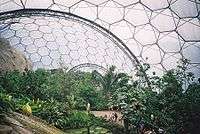 Inside the tropical Biome
Inside the tropical Biome- The Biomes (or eco domes) at The Eden Project in Cornwall.
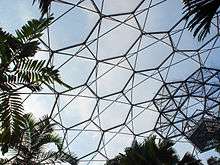 The hexangle structure looking from the inside
The hexangle structure looking from the inside
The Core
The Core is the latest addition to the site and opened in September 2005. It provides the Eden Project with an education facility, incorporating classrooms and exhibition spaces designed to help communicate Eden's central message about the relationship between people and plants. Accordingly, the building has taken its inspiration from plants, most noticeable in the form of the soaring timber roof, which gives the building its distinctive shape.
Grimshaw developed the geometry of the copper-clad roof in collaboration with a sculptor, Peter Randall-Page, and Mike Purvis of structural engineers SKM Anthony Hunts. It is derived from phyllotaxis, which is the mathematical basis for nearly all plant growth; the "opposing spirals" found in many plants such as the seeds in a sunflower's head, pine cones and pineapples. The copper was obtained from traceable sources, and the Eden Project is working with Rio Tinto Group to explore the possibility of encouraging further traceable supply routes for metals, which would enable users to avoid metals mined unethically. The services and acoustic, mechanical and electrical engineering design was carried out by Buro Happold.
Art at The Core
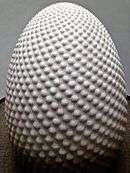
The Core is also home to art exhibitions throughout the year. A permanent installation entitled Seed, by Peter Randall-Page, occupies the anteroom. Seed is a large, egg-shaped stone installation displaying a complex pattern of protrusions that are based upon the geometric and mathematical principles that underlie plant growth.
Environmental aspects
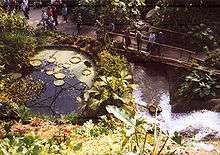
The domes provide diverse growing conditions, and many plants are on display.
The Eden Project includes environmental education focusing on the interdependence of plants and people; plants are labelled with their medicinal uses. The massive amounts of water required to create the humid conditions of the Tropical Biome, and to serve the toilet facilities, are all sanitised rain water that would otherwise collect at the bottom of the quarry. The only mains water used is for hand washing and for cooking. The complex also uses Green Tariff Electricity – the energy comes from one of the many wind turbines in Cornwall, which were among the first in Europe.
Controversially, one of the companies the Eden Project currently partners with is the British mining company Rio Tinto Group.[5]
In December 2010 the Eden Project received permission to build a geothermal electricity plant which will generate approx 4MWe, enough to supply Eden and about 5000 households.[6]
History
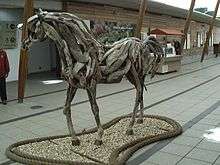

The clay pit in which the project is sited was in use for over 160 years.[8] In 1981, the pit was used by the BBC as the planet surface of Magrathea in the 1981 TV series of the Hitchhiker's Guide to the Galaxy.[9] By the mid-1990s the pit was all but exhausted.[10]
The initial idea for the project dates back to 1996, with construction beginning in 1998. The work was hampered by torrential rain in the first few months of the project, and parts of the pit flooded as it sits 15 m (49 ft) below the water table.[10]
The first part of the Eden Project, the visitor centre, opened to the public in May 2000. The first plants began arriving in September of that year,[10] and the full site opened on 17 March 2001.
The Eden Project was used as a filming location for the 2002 James Bond film, Die Another Day (starring Pierce Brosnan). On 2 July 2005 The Eden Project hosted the "Africa Calling" concert of the Live 8 concert series. It has also provided some plants for the British Museum's Africa garden.
In 2005, the Project launched "A Time of Gifts" for the winter months, November to February. This features an ice rink covering the lake, with a small café/bar attached, as well as a Christmas market. Cornish choirs regularly perform in the biomes.
On 6 December 2007, the Eden Project invited people all over Cornwall to try to break the world record for the biggest ever pub quiz as part of its campaign to bring £50 million of lottery funds to Cornwall.[11]
In December 2007, the project failed in its bid for £50 million of funding, after the Big Lottery Fund popular vote,[12] when it received just 12.07% of the votes, the lowest for the four projects being considered.[13] Eden wanted the money for Edge, a proposed desert biome that was going to look at people and plants living on the edge today and the solutions that they have come up with to the challenge of living within limits.[14]
In December 2009, much of the project, including both greenhouses, became available to navigate through Google Street View.
The Eden Trust revealed a trading loss of £1.3 million for 2012-13,on a turnover of £25.4 million. The Eden Project had posted a surplus of £136,000 for the previous year. In 2014 Eden accounts showed a surplus of £2 million.[15]
The World Pasty Championships have been held at the Eden Project since 2012, an international competition to find the best Cornish pasties and other pasty-type savoury snacks.[16][17] The Eden Project is said to have contributed over £1 billion to the Cornish economy.[18]
Eden Sessions
Since 2002, the Project has hosted a series of musical performances, called the Eden Sessions. Artists have included Amy Winehouse, James Morrison, Muse, Lily Allen, Snow Patrol, Pulp, Brian Wilson and The Magic Numbers. 2008's summer headliners were: The Verve, Kaiser Chiefs, and KT Tunstall. Oasis were also set to play in the summer of 2008, but the concert was postponed because Noel Gallagher was unable to perform after breaking three ribs in a stage invasion incident several weeks before. The concert was instead played in the summer of 2009.[19] 2010 saw performances from artists including Mika, Jack Johnson, Mojave 3, Doves, Paolo Nutini, Mumford & Sons, and Martha Wainwright.
The 2011 sessions were headlined by The Flaming Lips, Primal Scream, Pendulum, Fleet Foxes and Brandon Flowers with support from The Horrors, The Go! Team, OK Go, Villagers, and The Bees.[20]
The 2012 Eden sessions were headlined by: Tim Minchin, Example, Frank Turner, Chase & Status, Plan B, Blink-182, Noah and the Whale, and The Vaccines.[20]
The 2013 Eden Sessions were headlined by: Kaiser Chiefs, Jessie J, Eddie Izzard, Sigur Rós, and The xx.[20]
The 2014 Eden Sessions were headlined by: Dizzee Rascal, Skrillex, Pixar in Concert, Ellie Goulding and Elbow.[20]
The 2015 Eden Sessions were headlined by: Paolo Nutini, Elton John, Paloma Faith, Motörhead, The Stranglers, Spandau Ballet and Ben Howard.[20]
The 2016 Eden Sessions were headlined by: Lionel Richie, Tom Jones, PJ Harvey, Manic Street Preachers and Jess Glynne.[20]
In the media
- Robin Kewell (Ed.): Eden: The Inside Story. St Austell n.d.: The Eden Project. DVD.
- The Eden Radio Project. Every Thursday between 5:30 and 7 p.m. on Radio St Austell Bay.
- Die Another Day: Graves' diamond mine
See also
- BIOS-3
- Biosphere 2
- Closed ecological system
- Integrated biotectural system
- Montreal Biodome
- Montreal Biosphère
- Mitchell Park Horticultural Conservatory ("The Domes" of Milwaukee)
- Ecosystem
- Vivarium
- The Lost Gardens of Heligan
- List of topics related to Cornwall
- Earthpark
- Sir Richard Carew Pole
- Thin-shell structure
- List of thin shell structures
References
- ↑ Baldwin, Jay. "The Pillow Dome" (PDF). Engineering. The Buckminster Fuller Institute. Retrieved 9 February 2014.
- ↑ Ordnance Survey (2005). OS Explorer Map 107 – Fowey, Looe & Lostwithiel. ISBN 0-319-23708-7.
- ↑ "Rainforest Biome". Eden project. Retrieved 11 October 2011.
- ↑ "Our history". Eden project. Retrieved 27 September 2010.
- ↑ "New Eden Project book shows what can be done with disused mines". Eden project.
- ↑ "BBC News – Eden Project geothermal plant plans to go ahead". BBC News. 18 December 2010. Retrieved 18 December 2010.
- ↑ "Heather Jansch Sculptor Bronze & Driftwood Horse". Heather Jansch.
- ↑ "Our Story". Eden Project. Archived from the original on 12 July 2012.
- ↑ Turner, Jenny (3 October 2009). "Does the Hitchhiker's Guide to the Galaxy still answer the ultimate question?". The Guardian. London.
- 1 2 3 "Eden story, educational charity – Eden Project, Cornwall". Eden Project.
- ↑ "About". Eden Project. Archived from the original on 26 December 2007.
- ↑ "Routes scheme tops lottery vote". BBC News. 12 December 2007. Retrieved 3 February 2008.
- ↑ "The People's 50 Million – Sustrans' Connect2 wins £50 million prize". The Big Lottery Fund. Retrieved 3 February 2008.
- ↑ "Eden edges closer to winning Lottery millions: Big Lottery Fund". Retrieved 16 May 2016.
- ↑ "St Austell’s Eden Project". Cornish Guardian. 15 June 2014.
- ↑ "World Pasty Championships winners chosen", BBC News, 4 March 2012, retrieved 2016-08-13
- ↑ Neil Shaw (5 March 2016), "Pictures as World Pasty Championships are held at Eden Project on St Piran's Day 2016", The Herald (Plymouth), retrieved 2016-08-13
- ↑ "Tim Smit KBE, Sir – Personally Speaking Bureau". Retrieved 16 May 2016.
- ↑ "Media relations". Eden Project.
- 1 2 3 4 5 6 "Previous line-ups – Eden Sessions concerts, Eden Project, Cornwall". Eden Sessions.
Further reading
- Philip McMillan Browse, Louise Frost, Alistair Griffiths: Plants of Eden (Eden Project). Penzance 2001: Alison Hodge.
- Richard Mabey: Fencing Paradise: Exploring the Gardens of Eden London 2005: Eden Project Books. ISBN 1-903919-31-2
- Hugh Pearman, Andrew Whalley: The Architecture of Eden. With a foreword by Sir Nicholas Grimshaw. London 2003: Eden Project Books. ISBN 1-903919-15-0
- Eden Team (Ed.): Eden Project: The Guide 2008/9. London 2008: Eden Project Books.
- Tim Smit: Eden. London 2001: Bantam Press.
- Paul Spooner: The Revenge of the Green Planet: The Eden Project Book of Amazing Facts About Plants. London 2003: Eden Project Books.
- Alan Titchmarsh: The Eden Project. United Kingdom: Acorn Media, 2006. OCLC 225403941.
External links
| Wikimedia Commons has media related to Eden Project. |
- Official website
- Eden Sessions Website—Official site for live gigs
- Webcam of the Eden Project—BBC